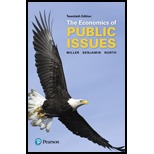
The incentive to find loopholes to reduce the federal tax liabilities and its difference from 91% federal personal income tax bracket to 15% federal personal income tax bracket.
Concept introduction:
Marginal income tax rate:
It is defined as the amount of tax paid on every external dollar of income. When the income rises, the marginal tax rate of a person also rises. This means that the person with low income are taxed low and those with high income are taxed high.
Federal income tax rate:
It is a type of progressive tax which is imposed by the federal government, states, and the local body in the United States. This means that as the income increases, the tax rate also increases.
Explanation:
- When the federal tax is 91%, then the people would try to find every possible way to evade taxes. During 1951, 91% of the federal tax meant for every additional income of $1,91 cents were paid as tax and only 9 cents were left as disposable income.
- This meant that the cost associated with the tax evasion is less than the benefit. So, people used to find legal loopholes to evade taxes.
- When the federal tax is 15%, then the people have no incentive to evade taxes. 15% of the federal tax means that for every additional income of $1, 15 cents are paid as tax and 85 cents are left as disposable income.
- This means that the cost associated with the tax evasion is more than the benefit. So, people prefer to pay tax rather than to evade it. The cost of evasion that is fines, punishments, and penalties are very high, as compared to high federal taxes.
Want to see the full answer?
Check out a sample textbook solution
Chapter 14 Solutions
Pearson eText for Economics of Public Issues -- Instant Access (Pearson+)
- Answerarrow_forwardM” method Given the following model, solve by the method of “M”. (see image)arrow_forwardAs indicated in the attached image, U.S. earnings for high- and low-skill workers as measured by educational attainment began diverging in the 1980s. The remaining questions in this problem set use the model for the labor market developed in class to walk through potential explanations for this trend. 1. Assume that there are just two types of workers, low- and high-skill. As a result, there are two labor markets: supply and demand for low-skill workers and supply and demand for high-skill workers. Using two carefully drawn labor-market figures, show that an increase in the demand for high skill workers can explain an increase in the relative wage of high-skill workers. 2. Using the same assumptions as in the previous question, use two carefully drawn labor-market figures to show that an increase in the supply of low-skill workers can explain an increase in the relative wage of high-skill workers.arrow_forward
- Published in 1980, the book Free to Choose discusses how economists Milton Friedman and Rose Friedman proposed a one-sided view of the benefits of a voucher system. However, there are other economists who disagree about the potential effects of a voucher system.arrow_forwardThe following diagram illustrates the demand and marginal revenue curves facing a monopoly in an industry with no economies or diseconomies of scale. In the short and long run, MC = ATC. a. Calculate the values of profit, consumer surplus, and deadweight loss, and illustrate these on the graph. b. Repeat the calculations in part a, but now assume the monopoly is able to practice perfect price discrimination.arrow_forwardThe projects under the 'Build, Build, Build' program: how these projects improve connectivity and ease of doing business in the Philippines?arrow_forward

 Principles of Economics (12th Edition)EconomicsISBN:9780134078779Author:Karl E. Case, Ray C. Fair, Sharon E. OsterPublisher:PEARSON
Principles of Economics (12th Edition)EconomicsISBN:9780134078779Author:Karl E. Case, Ray C. Fair, Sharon E. OsterPublisher:PEARSON Engineering Economy (17th Edition)EconomicsISBN:9780134870069Author:William G. Sullivan, Elin M. Wicks, C. Patrick KoellingPublisher:PEARSON
Engineering Economy (17th Edition)EconomicsISBN:9780134870069Author:William G. Sullivan, Elin M. Wicks, C. Patrick KoellingPublisher:PEARSON Principles of Economics (MindTap Course List)EconomicsISBN:9781305585126Author:N. Gregory MankiwPublisher:Cengage Learning
Principles of Economics (MindTap Course List)EconomicsISBN:9781305585126Author:N. Gregory MankiwPublisher:Cengage Learning Managerial Economics: A Problem Solving ApproachEconomicsISBN:9781337106665Author:Luke M. Froeb, Brian T. McCann, Michael R. Ward, Mike ShorPublisher:Cengage Learning
Managerial Economics: A Problem Solving ApproachEconomicsISBN:9781337106665Author:Luke M. Froeb, Brian T. McCann, Michael R. Ward, Mike ShorPublisher:Cengage Learning Managerial Economics & Business Strategy (Mcgraw-...EconomicsISBN:9781259290619Author:Michael Baye, Jeff PrincePublisher:McGraw-Hill Education
Managerial Economics & Business Strategy (Mcgraw-...EconomicsISBN:9781259290619Author:Michael Baye, Jeff PrincePublisher:McGraw-Hill Education





